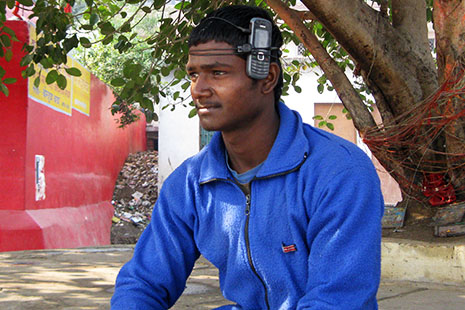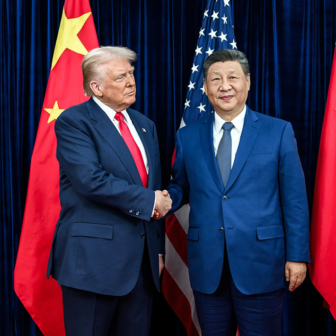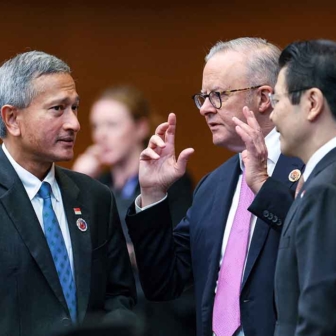I FIRST MET Rakesh many years ago on the ghats (landings) of the holy river Ganges in the city of Varanasi. He offered to take me for a boat ride, an absolute must-do for a tourist, like me, visiting the city for the first time. Since then I have returned many times – as a tourist, a tour guide and now an anthropologist studying the city and its inhabitants. Rakesh and I kept in contact by mail over the years, off and on, though I only really caught up with what he was doing when I was back in Varanasi. Then, on a recent trip to the city, he proudly showed me his new mobile phone, saying that from now on we would be able to speak anytime, anywhere. He also asked me to give his mobile number to all my friends who intend to visit the city. Through the mobile phone he has been able to increase his earnings markedly, he said, with people from all over the world booking his boat in advance.
Among members of the boatman community who work on the Ganges ferrying passengers, Rakesh is one of the few who can read and write in basic English, thanks to his own initiative. The mobile phone gives him the means to communicate and maintain contact with his friends and clients, both in Varanasi and around the globe. Since his first purchase Rakesh has already replaced his mobile twice with increasingly advanced sets. We now keep in touch via text messages and, on special occasions, person-to-person calls.
India’s mobile phone revolution is in full swing. According to the telecommunications regulator, 506 million Indians have a mobile phone subscription of some kind. Naturally, the burgeoning Indian middle class sees the mobile phone as a sign that it is partaking of the global largesse of consumer capitalism. Among the poorer classes, the picture is more complicated. Pointing to cases of hardy entrepreneurship, the pundits keep telling us that the mobile phone is playing a revolutionary role as an antidote to social and economic deprivation and the ultimate levelling device. But this view glosses over the significant social and economic inequalities that inhibit the life chances of those whose primary concern continues to be simply making ends meet. For poorer people who do have some measure of security and stability, however, the mobile phone is certainly affecting their daily lives in significant ways. Among the millions who have never even owned a landline, the mobile phone has become the primary way to communicate with their relatives and friends and enables them to micro-coordinate daily activities to levels never seen before.
Not surprisingly, this affects the way people view and interact with others. Among women, for example, the mobile phone can mean increased independence, safety and mobility. One friend, who previously would have never allowed his wife, Veena, to travel the several hundred kilometres to her mother’s house without a male relative escorting her, now feels comfortable with the idea, secure in the knowledge that Veena can be contacted any time and will be met immediately upon arrival. But although this change has the potential to empower women, it also has the potential to increase surveillance of their movements. For young people too, the mobile phone has opened new opportunities for unmediated communication. Gopi, a boatman from Varanasi, speaks daily with his soon-to-be wife, located in a city over 500 kilometres away. Theirs is an arranged marriage, and apart from a brief meeting at which both families were present, the only chance to get to know each other better before they marry is by phone.
In Varanasi, India’s most sacred city and one of its most religious and socially conservative strongholds, public spaces are filled with songs and screensavers displaying a range of animated images, ranging from gods and saints to Bollywood heroes and heroines. In some cases the ringtones, wallpapers, screensavers and welcome notes evoke a sense of reverence, creating a tiny mobile shrine for its user. Pilgrims to the city relay their experience to their families, recording their sacred journeys and bringing images and sounds home with them (along with the usual pot of holy Ganges water). The mobile phone is changing lives with unanticipated effects, altering communication routes, cultural practices (such as marriage and pilgrimage) and ideas about privacy and intimacy.
Remarkably, the illiterate and semi-literate display an acute sense of technological know-how when it comes to operating mobile phones. While texting is rare among these people, digital technology, including cameras and multimedia players, have become an integral part of their lives.
On one of my last visits to Varanasi I was captivated by an animated image of the god Ganesh adorning the screen of a friend’s mobile. He too is a boatman and belongs to the Mallah caste, near the bottom of the Hindu caste hierarchy. At one point he asked me whether my own phone had Bluetooth, to which I embarrassingly replied that I was not sure what he meant. In a matter of minutes he was able to pair both our mobiles so I too could receive this “auspicious viewing” of the sacred image.
Shiva, a longtime friend from Varanasi, who can barely read and write, now possesses a Nokia N72 with camera and video features with which he can document his life. He shows me his son’s mundan ceremony (the auspicious shaving of the head) and proudly displays photos of his newly built houseboat, all the while playing (at full volume) his favourite Bollywood songs. Another boatman documented his brother’s untimely death, which he tells me is vital photographic evidence as the police are likely to write off the incident as an “accident” (a common practice in relation to the underprivileged in India) and close the case once they receive their bribe. Does this mean justice will be done? Perhaps. But the wider structures of social and economic inequality persist and for this boatman, at least, the fees involved in hiring an attorney and going through the protracted process of litigation render these digital images far less potent than they might otherwise have been.
Mobile phones have also changed the urban landscape of many cities in India, replacing many of the common STD (subscribers trunk dialling) booths, widely used over the last two decades by Indians who were unable to have their own landline because of cost and lack of infrastructure. Shops and outlets selling mobile phones and paraphernalia saturate the streets, with legitimate shops, fix-it places and numerous illegal downloading stations jostling for attention. For a sum of Rs50 (approx US$1.10) I could have downloaded a 1GB package of hundreds of songs and images.
The mobile axis mundi of Varanasi is the bustling Muslim market of dal mandi. This busy market mainly offers illegal sets and various mobile accessories. On display is a variety of mobiles for very reasonable prices, including the ePhone – a rip-off of the iPhone. Colloquially, these sets are known as “China mobiles,” and while everyone knows that China mobiles have “no guarantee, no warranty,” it is these phones that are setting the standard for other more reputable brands. The most notable example of this competitive environment is the emergence of cheap mobiles that can use two and three SIM cards simultaneously, responding to the fact that people want to take advantage of the variable rates that different cards offer. Samsung and other Indian brands have recently taken up this innovation, and Nokia is likely to follow – a remarkable example of the lower classes driving the market.
To speak of mobile phones empowering poorer Indians is perhaps premature, not least because it is largely their ongoing subordination that keeps the great Indian middle classes thriving. Nevertheless, mobile phones have instigated a process of democratisation, as this new form of media and technology evades traditional social hierarchies and structures with consequences that are yet to be fully appreciated. •
Assa Doron is a research fellow in the School of Culture, History and Language at the Australian National University.




